When it comes to restoring smiles and functionality, full-arch dental implants have revolutionized the field of dentistry. Two popular treatment options are All on 4 and All on 6. These solutions provide patients with a fixed set of teeth that mimic the natural aesthetic and function while addressing the emotional repercussions associated with tooth loss. Understanding the intricacies of these treatments can help you make an informed decision that’s not just about numbers but also about your overall well-being.
The future of Full-arch restoration
Tooth loss is more than just a physical ailment; it has emotional, psychological, and functional implications that can affect one’s quality of life. The shift from removable dentures to fixed full-arch implant systems symbolizes a significant leap in dental technology, offering patients restored confidence alongside improved functionality.
Emotional and functional impact of tooth loss
The emotional toll of losing one or multiple teeth can be profound. Many individuals experience feelings of embarrassment, self-consciousness, and social anxiety. This can lead to avoiding social interactions or even withdrawal from activities they once enjoyed. The psychological impact is compounded when considering how integral our smile is to communication and expressing emotions.
Functionally, missing teeth can affect eating habits, speech, and even facial structure over time. When teeth are lost, it can lead to bone resorption, further complicating the ability to get effective restorative work done later. All in all, the implications of tooth loss extend beyond aesthetics; they seep into daily life and relationships, making restoration not just about replacing teeth but reclaiming one’s confidence and lifestyle.

Shift from removable dentures to fixed Full-arch implant systems
Traditionally, removable dentures were the go-to solution for tooth loss, but they come with a host of limitations, from discomfort to dietary restrictions. With the advent of implant technology, fixed full-arch systems like All on 4 and All on 6 offer a game-changing alternative. These systems allow for immediate function, providing patients with the ability to eat, speak, and smile with renewed assurance.
While removal dentures can slip or cause soreness, full-arch implants are anchored securely in the jawbone, mimicking the stability of natural teeth. This advancement means that individuals can enjoy their favorite foods, engage confidently in conversations, and feel secure in social settings, dramatically improving their quality of life.
Why the conversation must go beyond just “All on 4 vs. All on 6”
Though All on 4 and All on 6 are often pitted against each other in discussions about full-arch restorations, the conversation should extend beyond mere quantity. Each patient’s unique dental anatomy, lifestyle, and personal preferences must be considered. It is essential to delve into aspects like bone density, gum health, and individual goals for treatment. Rather than focusing solely on a numerical comparison, a holistic approach that encompasses the entire dental ecosystem will lead to better long-term outcomes.
All on X: What does the X really mean?
The term “All on X” encompasses various configurations for full-arch dental implants, including All-on-4, All on 5, and All on 6, with the ‘X’ representing the number of implants used. While it may seem straightforward at first glance, understanding this concept requires a deeper look into strategic implant placement rather than merely counting the implants.
Overview of “All-on-4”, “All on 6”, and even “All on 5”
The All-on-4 system employs four strategically placed implants to support a complete arch of replacement teeth. This method is particularly beneficial for patients with lower bone density, as it often allows for the use of angled implants to maximize support.
On the other hand, the All on 6 utilizes six implants for additional support, which can be advantageous for individuals with sufficient bone density who desire increased stability, especially for larger prosthetic bridges. Some practitioners may even recommend an All on 5 approach, taking advantage of specific anatomical considerations. Such variations illustrate the flexibility inherent in modern dental implantology.
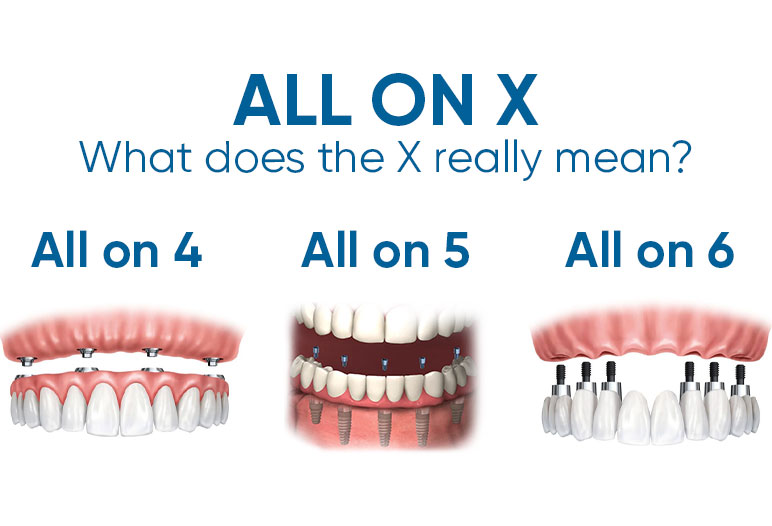
Understanding strategic implant positioning, not just quantity
The positioning of implants plays a pivotal role in ensuring the success of the restoration. Dental professionals often consider factors such as bone quality and volume, occlusion, and even the position of existing teeth.
Implants placed in the anterior (front) region generally provide more stability due to denser bone in that area. In contrast, posterior areas may require angulated implants to anchor effectively. This strategic approach allows for optimal load distribution and promotes longevity, proving that where the implants are placed can be even more important than how many there are.
Here is our dental implants price at Saigon Implant Center:
| SINGLE-TOOTH IMPLANTS | DENTAL COST (USD) | DISCOUNT PRICE (USD) |
| Premium Korean implant (Dentium) | 800 | 720 |
| US implant (Dentium) | 960 | 880 |
| Italian implant (C-Tech) | 1,000 | 920 |
| US implant (Superline) | 1,080 | 1,000 |
| France/Switzerland (Kontact / Neodent) | 1,240 | 1,080 |
| Super Active (Nobel/Straumann) | 1,600 | 1,440 |
| Titanium-porcelain restoration | 160 | |
| Full Zirconia CAD/CAM Crown on Implant | 280 | |
| FULL 1 JAW IMPLANTS | DENTAL IMPLANTS COST (USD) | DISCOUNT PRICE (USD) |
| Implant ALL ON 4 Dentium (Korea) (Include screw only + Temporary strengthened crown) | 6,000 | 4,000 |
| Implant ALL ON 4 Straumann Neodent (Swiss) (Include screw only + Temporary strengthened crown) | 7,000 | 5,200 |
| Implant ALL ON 4 Nobel / Straumann SLA Active (Include screw only + Temporary strengthened crown) | 9,000 | 7,200 |
| Implant ALL ON 6 Dentium (Korea) (Include screw only + Temporary strengthened crown) | 8,000 | 5,600 |
| Implant ALL ON 6 Straumann Neodent (Swiss) (Include screw only + Temporary strengthened crown) | 9,000 | 7,600 |
| Implant ALL ON 6 Nobel / Straumann SLA Active (Include screw only + Temporary strengthened crown) | 12,000 | 10,400 |
| Zygomatic Implants – “All on 4”, full arch, fixed bridge | 13,000 | |
| Final bar + High Acrylic Permanent teeth (4–6 Months Later) | 1,400 | |
| Final bar + Full Zirconia CAD/CAM teeth (4–6 Months Later) | 4,000 | |
|
For patients deciding on Implants All-On treatment SAIGON IMPLANT CENTER will give customers a gift package, including: |
|
|
How 3D diagnostics determine the personalized number of implants
Advancements in 3D imaging technology have fundamentally transformed the way dental professionals assess and plan treatment. Utilizing cone beam computed tomography (CBCT) scans, dentists can analyze the patient’s oral anatomy, including bone density and spatial relationships among structures.
This detailed visualization enables practitioners to determine the most effective number and placement of implants specific to a patient’s needs. Consequently, decisions regarding whether to pursue All on 4, 5, or 6 can be made based on solid evidence rather than arbitrary numbers, leading to better outcomes and satisfaction for the patient.
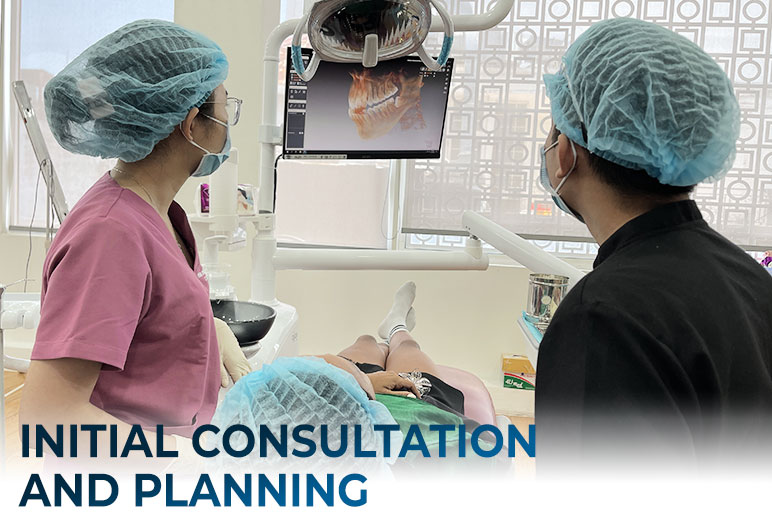
Myth: More implants = Always better?
A common misconception in dental care is that more implants automatically translate to better results. However, this isn’t always the case. Excessive implants could lead to complications such as overcrowding, increased surgical trauma, or unnecessary costs without tangible benefits.
What truly matters is the quality of the implants, their positioning, and how they integrate with the jawbone and gum tissue. Thus, the focus should remain on achieving the optimal balance between functionality and aesthetics rather than simply maximizing the number of implants.
Engineering the smile: The hidden art behind implant planning
Designing a perfect smile involves a combination of science and artistry. Having a thorough understanding of facial aesthetics, occlusion, and digital planning tools can significantly improve the outcome of full-arch restorations.
Role of digital smile design, facial harmony, and occlusion
Digital Smile Design (DSD) has revolutionized the way dental professionals approach smile engineering. By utilizing software that simulates potential outcomes, patients can visualize what their new smile might look like before any procedures begin.
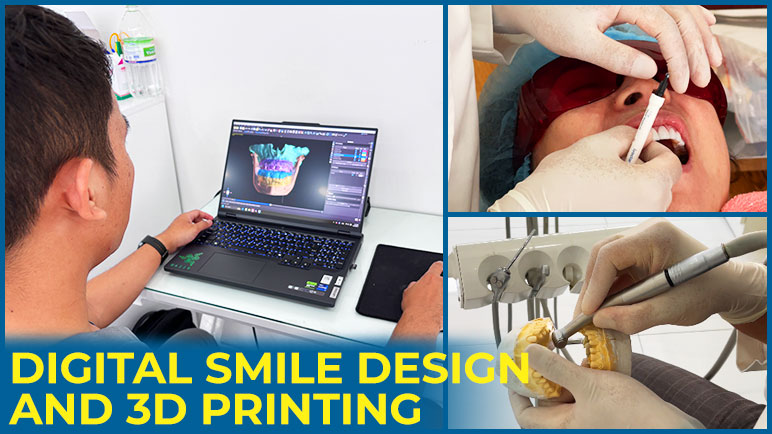
Achieving facial harmony is another paramount consideration. A properly designed prosthetic must complement the patient’s overall facial features, ensuring that the size, shape, and color of the prosthetic teeth align with what would naturally fit the patient’s face. The occlusal relationship—how upper and lower teeth fit together—is also essential for functional success, as poor alignment can lead to discomfort and long-term issues.
Bone density mapping and angulated implants (Tilted implant technique)
Bone density mapping is crucial in determining the best implant placement strategy. Low-density areas may necessitate modifications, such as using angled or tilted implants—the Tilted Implant Technique—which can enhance stability by engaging denser bone regions.
By tilting implants toward the back of the mouth, it allows for an increase in available space for both the implants and the resulting prostheses, minimizing bone grafting requirements. This technique leads to reduced surgical time and enhances overall efficiency in the restoration process.
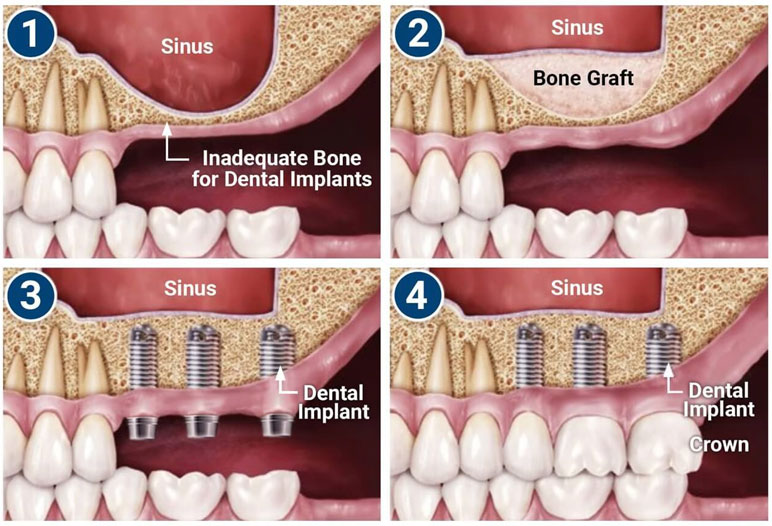
Immediate loading: Science of walking out with teeth the same day
One of the most alluring aspects of modern full-arch implants is the ability for patients to receive temporary teeth immediately following the procedure—a concept referred to as “immediate loading.”
With proper planning and ideal conditions, patients can leave the office the same day with functional teeth. This immediate gratification not only helps restore functionality but also greatly enhances the psychological benefit of seeing a smile restored in real-time. Nevertheless, careful monitoring and follow-up appointments are still needed to ensure everything heals correctly.
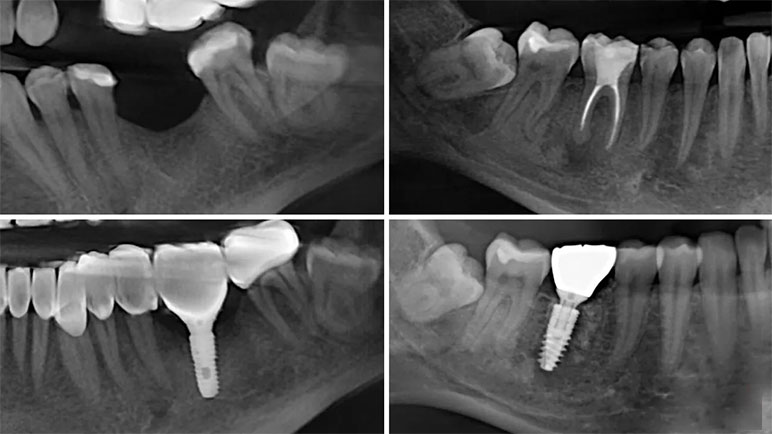
Collaboration between the surgeon, prosthodontist, and lab technician
The success of implant planning and execution relies heavily on the collaboration between the surgeon, prosthodontist, and lab technician. Effective communication among these professionals ensures a seamless workflow from initial consultation through to final delivery of the prosthesis.
Each specialist brings their expertise to the table—surgeons focus on implant placement, prosthodontists design the aesthetic aspects, and technicians craft the final product. This holistic approach maximizes the chances of achieving an optimal outcome, tailored specifically for each individual patient.
Material matters: Zirconia vs Acrylic vs Hybrid
When selecting materials for full-arch restorations, the choice between zirconia, acrylic, and hybrid options can significantly influence both aesthetics and durability.
Aesthetic showdown: Monolithic Zirconia vs PMMA vs Titanium Hybrid
Zirconia has garnered a reputation as the gold standard for high-end restorations. Its natural translucency closely mimics that of real teeth, providing superior cosmetic results.
In comparison, PMMA (Polymethyl methacrylate) acrylic is a popular choice for temporary restorations due to its lower cost and lightweight nature, but lacks the durability and resistance to staining found in zirconia. Hybrid options, combining titanium frameworks with acrylic teeth, strike a balance between strength and aesthetics, though they may not fully integrate with the body like zirconia does.
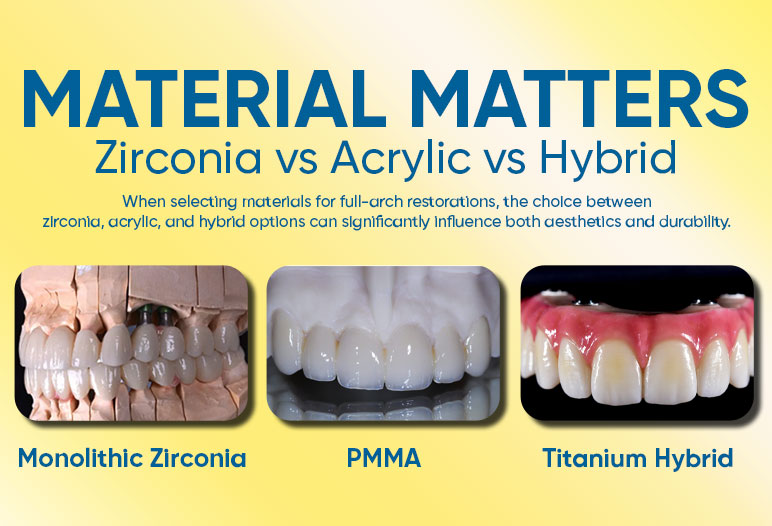
Long-Term durability vs. Upfront affordability
While the upfront cost of materials like zirconia may be higher, it is crucial to consider long-term durability. Zirconia bridges can last well over a decade with appropriate care compared to acrylic options, which may require more frequent replacements.
Investing in premium materials can translate to significant savings over time, as patients can avoid the hassle and financial burden of replacing their prostheses sooner rather than later.
Why Zirconia bridges are becoming the gold standard in premium cases
Zirconia bridges possess the qualities of strength, aesthetic appeal, and biocompatibility, making them increasingly favored in complex cases. As dental technology advances, zirconia continues to evolve, incorporating innovative techniques that enhance its properties, such as improved shade matching and increased flexural strength.
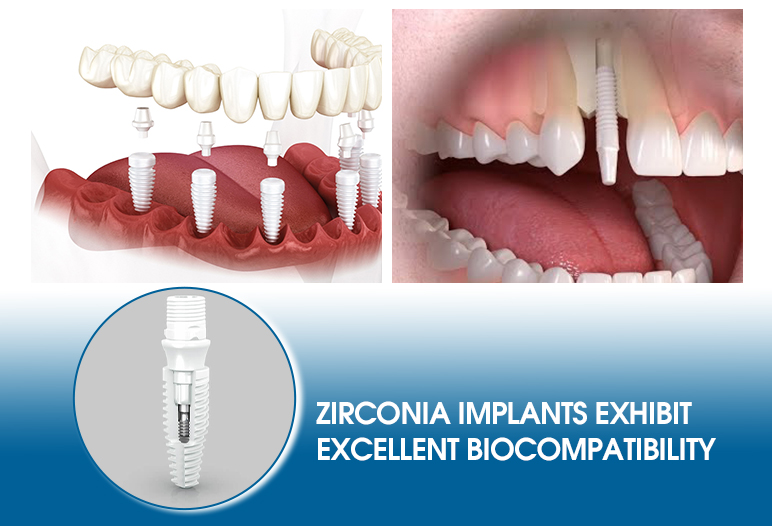
Moreover, the ability to mill zirconia in-house streamlines production, allowing for quicker turnaround times and greater customization. As a result, more dental practices are transitioning towards zirconia as the material of choice for full-arch restorations, especially in cases where aesthetics and longevity are paramount.
Cleaning, maintenance, and how materials affect gum health
Each material poses different challenges concerning cleaning and maintenance. While zirconia tends to resist plaque accumulation and supports gum health, acrylic can be prone to staining and wear over time.
Regular cleanings and at-home care routines are essential regardless of the material chosen. Understanding the characteristics of the selected material can aid in developing a consistent regimen that encourages longevity and health for both the prosthesis and the surrounding gums.
Beyond the procedure: What could go wrong (and how to Prevent It)
Even with advanced technology and meticulous planning, complications can arise post-procedure. Awareness and proactive measures can mitigate many potential issues.
Implant failure causes: Smoking, bruxism, poor oral hygiene
Several factors can contribute to implant failure, some of which are controllable by the patient. Smoking, bruxism (teeth grinding), and subpar oral hygiene directly impact the success of implants.
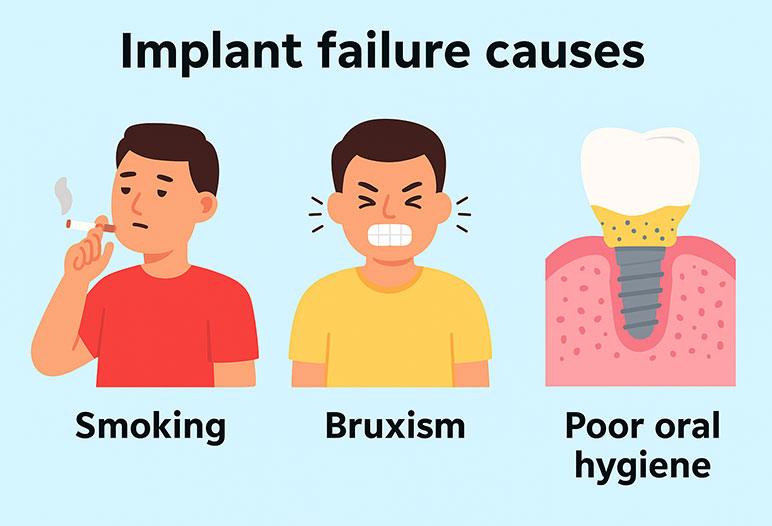
Patients who smoke are more susceptible to infections and slower healing rates, while bruxism exerts excessive forces on the implants, risking loosening or even fracture. Educating patients about maintaining good oral hygiene and addressing harmful habits prior to pursuing any restoration can significantly enhance the likelihood of successful outcomes.
Peri-implantitis and how modern designs reduce risks
Peri-implantitis is an inflammatory condition affecting the gums around an implant that can lead to bone loss. Advanced designs, such as those with smooth surfaces or antimicrobial coatings, help minimize this risk.
Maintaining regular check-ups and professional cleanings allows for early detection of any potential issues, thus preventing the progression of peri-implantitis and preserving the integrity of the implant.
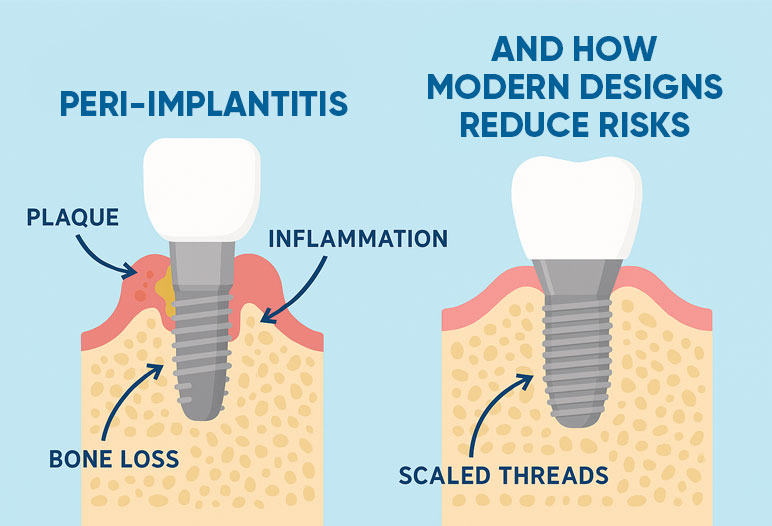
Prosthetic complications: From loose screws to bite discomfort
Prosthetic complications can manifest in various forms, including loose screws or bite discomfort. These issues can stem from manufacturing defects, improper seating, or changes in the bite over time.
Regular monitoring and check-ups are crucial for addressing these complications swiftly. Being proactive about adjustments and seeking immediate attention if discomfort occurs can prevent prolonged issues that might compromise the restoration.
Importance of aftercare and ongoing monitoring (e.g., Annual torque check)
Aftercare is vital for the longevity of full-arch implants. Regular visits for monitoring, including annual torque checks, help ensure that everything remains stable and functioning well. These check-ups allow dental professionals to assess the condition of the implants and prosthetics, facilitating timely intervention if any complications arise.
Highlighting the importance of aftercare reinforces the idea that successful restoration extends beyond the initial procedure. Patients must commit to lifelong maintenance to safeguard their investment in both their dental health and overall well-being.
Expert insight: Questions you should ask before saying yes
When considering full-arch restorations like All on 4 and All on 6, it’s prudent to arm yourself with knowledge. Ensure you ask the right questions before committing to a dental practice.
How many All on X cases has the clinic done?
Experience matters in dental implantology. Inquire about the clinic’s track record with All on X procedures. A practitioner with extensive experience is likely to be familiar with various scenarios and complexities, increasing your confidence in their capability to handle your unique case.
Is the Zirconia bridge milled in-house or outsourced?
Understanding whether the zirconia bridge is milled on-site or sent to an external laboratory can impact quality control and turnaround times. Milling in-house often allows for greater precision and adjustments, reducing the potential for errors during production.
What’s the protocol for aftercare and emergency adjustments?
Knowing the clinic’s protocol for aftercare is crucial for ongoing success. Inquire about the frequency of follow-ups, recommended home-care routines, and how to handle potential emergencies. A well-defined aftercare strategy reflects a commitment to the patient’s long-term health and satisfaction.
Can you see before–and–after cases of patients similar to you?
Requesting before-and-after photos of similar patient cases provides insight into the practice’s aesthetic capabilities and results. Seeing tangible examples of previous work can instill confidence in your decision-making process and clarify expectations.
Conclusion
Whether choosing All on 4, 5, or 6 implants, the key to success lies in a customized approach that addresses each patient’s unique needs. Investing in precision and thoughtful planning will yield lasting benefits, enhancing not just your smile but your overall life quality. Remember, your smile is a lifelong asset—choose a partner who prioritizes your individual journey over a one-size-fits-all approach.

 Google Reviews
Google Reviews Call
Call
SAIGON IMPLANT CENTER
Best dentist in Vietnam
Saigon Implant Center - Dental Clinic utilizes the latest technology for specialized treatment in the field of Single implant, full jaw implants, All on 4 implants, All on 6 implants, Zygoma implant....
SAIGON IMPLANT CENTER
Best dentist in Vietnam
Saigon Implant Center - Dental Clinic utilizes the latest technology for specialized treatment in the field of Single implant, full jaw implants, All on 4 implants, All on 6 implants, Zygoma implant....